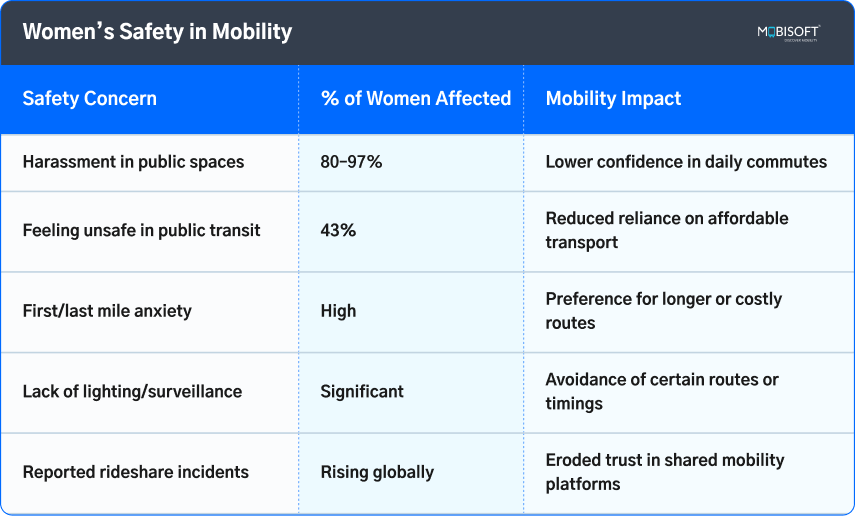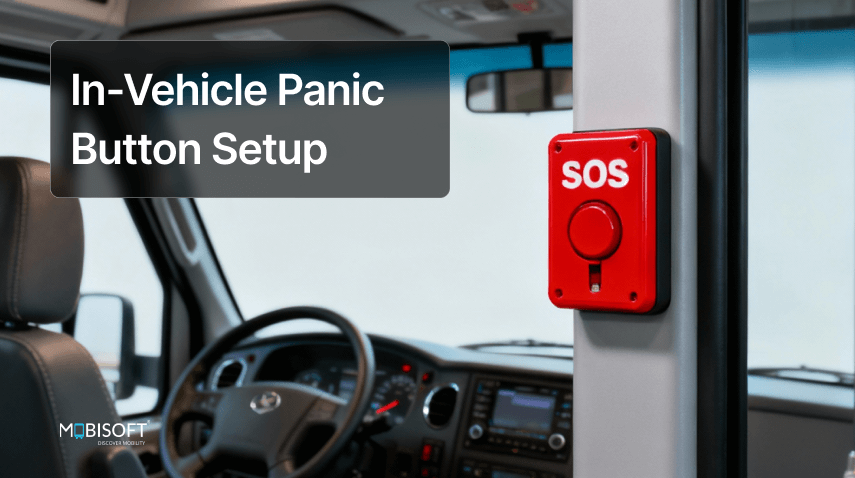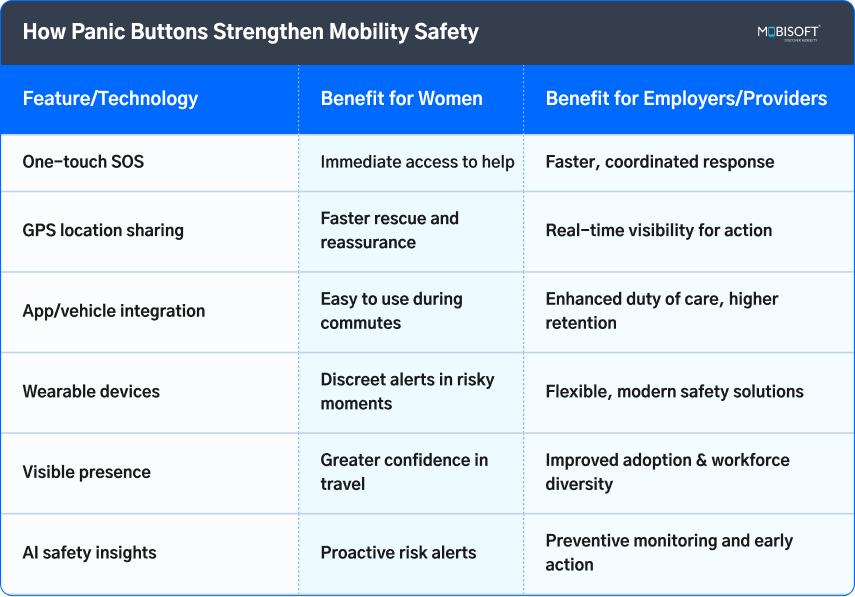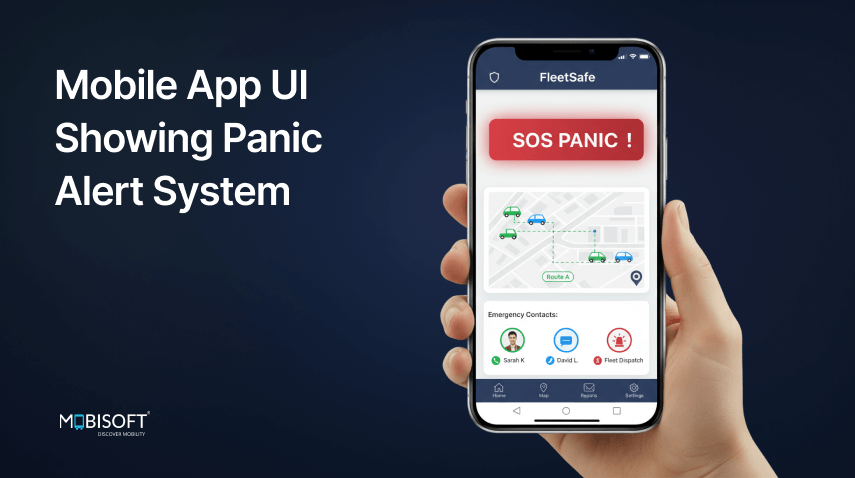While technology and innovation push society ahead, women still feel unsafe during travel. Even more concerning, reports and surveys highlight this reality without showing many signs of improvement. Be it public transportation, ridesharing, or through their daily work commutes, concerns about women's safety remain significant.
An Observer Research Foundation survey revealed that 56% of women interviewed had been sexually harassed on public transport, and 50% had given up educational or employment opportunities out of fear for safety on their daily commute. These frightening numbers serve to highlight that safety is more than a social issue. It is a workplace and mobility challenge that directly impacts companies, employees, and service providers.
One critical solution gaining traction is the use of panic buttons. These panic button systems provide women with a direct way to call for help during emergencies. Whether integrated into transport apps or vehicles, they link users to law enforcement or security teams instantly. This article explores how panic buttons strengthen women’s safety, the technology behind them, and their long‑term impact in corporate and shared mobility contexts.
For enterprises looking to strengthen staff protection, exploring a robust employee transport safety solution can complement panic button systems.
The Silent Reality of Women’s Commutes
University of Manchester data shows massive rates of underreporting of sexual harassment and violence in public transport throughout the globe. Only 17% are reported. The risk does not just come during the journey. The “first and last mile” of travel often creates the greatest anxiety. These moments discourage women from using public transport and can force them into longer or costlier routes to feel secure.
Part of the problem stems from the poor design of transit spaces. Dimly lit areas, the absence of staff, and weak surveillance encourage harassment. In corporate mobility, women traveling for work may find themselves in unfamiliar zones, where the sense of exposure is even higher.
Shared mobility platforms face similar challenges. While services like ridesharing promise convenience, cases of harassment have been reported globally. These incidents erode trust and highlight why safety features, such as emergency panic buttons, cannot remain optional. Panic buttons for women, when integrated effectively, help restore confidence by offering a visible, immediate layer of protection.
Learn more about building safer shared mobility and logistics safety systems for employees and commuters.
Women’s Safety in Mobility – Key Insights

How can Panic Buttons be Helpful?

Panic buttons, though conceived as mere safety gadgets, are essential in emergencies. Their significance lies in minimizing delays so that women obtain immediate access to help upon feeling they are in harm's way. For corporate transportation as well as carpooling settings, this one aspect instills confidence and faith among users.
Immediate Access to Help
The first purpose of having panic buttons is speed. During emergencies, women shouldn't have to search for numbers or state their exact location. With one touch, they are instantly connected to a dedicated team. It can be in-house security staff, neighborhood police, or an emergency panic button hotline. That immediate response cuts out hesitation and ensures that help is delivered promptly.
Integration with Mobility Systems
In corporate fleets and shared transport apps, panic button systems are often built into mobile apps or vehicle systems. Several cab services also provide riders the option to press a panic button for ride-share vehicles that immediately shares trip details and location with local law enforcement. For employers, embedding cloud-based panic alert systems for vehicles into employee transport apps strengthens corporate duty of care and reassures staff that support is always within reach.
The Role of Location Tracking
Modern vehicle panic buttons are supported by GPS tracking. Once activated, they send exact location details to responders, which shortens response times. This level of visibility is critical in large cities where every minute matters.
Building User Confidence
The presence of panic buttons for women goes beyond handling emergencies. For women, the feature signals that their safety is being prioritized. For companies and mobility platforms, it demonstrates responsibility and commitment to user well-being. Over time, this visibility changes how women perceive commutes, allowing them to travel with greater confidence.
Businesses can also explore enhanced safety in corporate event transportation services to ensure secure commutes during large gatherings.

Case Studies of Successful Implementations
Real‑world examples highlight how panic buttons strengthen safety across corporate and shared mobility. These implementations show how effective design, quick response, and visible safety tools can transform the commuting experience for women.
Rideshare Platforms
- Global leaders in cab services have integrated panic button features or vehicle SOS systems into their rider apps.
- With a single tap, users can notify authorities and share live trip details. This integration has become a standard expectation among passengers.
- It also helped these platforms rebuild trust in markets where safety concerns had weakened customer loyalty.
- In several reported cases, riders credited the emergency panic button with preventing escalation during uncomfortable or unsafe journeys
Public Transport Systems
- Some public systems have adopted panic buttons for buses as part of wider security initiatives.
- For example, buses in Istanbul introduced AIS 140-compliant panic button systems linked to live surveillance cameras and security forces.
- This system gave women commuters both reassurance and proof of immediate monitoring.
- City officials reported improved perceptions of public safety, which encouraged more women to use buses instead of expensive alternatives.
Lessons for Future Adoption
- Panic buttons are most effective when paired with trained responders and transparent protocols.
- Continuous user feedback ensures that the feature stays simple, reliable, and effective.
- It is important to consistently build on feedback. It will help gain trust and encourage wider adoption with time.
- For other cities, employers, or mobility providers planning adoption, these studies provide a clear roadmap for building safer, trust‑driven commuting ecosystems.
Educational institutions can enhance student and staff safety through school bus safety solutions.
Smarter Panic Buttons Through Technology
Technology is at the center of today's panic button systems. The functionality of such tools does not depend only on the button itself, but on the ecosystem that complements it. Advances in connectivity, devices, and predictive analytics are raising the bar for safe delivery in both corporate and shared mobility settings.
GPS and Real‑Time Tracking
- Accurate location sharing is the foundation of any emergency response. Panic buttons today rely on GPS to transmit exact positions in seconds.
- In densely populated cities, this minimizes delay and allows responders to know where to take action.
- For businesses, pairing GPS with fleet safety panic button hardware provides one more level of insight so they may track worker safety throughout routes.
Mobile and App Integration
- Smartphones have made panic buttons for women more conveniently available than ever before. Many mobility providers integrate in-vehicle SOS systems directly into their rider and staff transportation apps.
- Instead of depending upon dedicated hardware, users can access safety instruments directly through an interface they are familiar with.
- Enterprise mobility platforms benefit from in-app alerts in that they provide a single channel for alerting, tracking, and responding.
Wearable Devices and Discreet Alerts
- Wearables, such as smartwatches, are expanding the role of emergency panic buttons for vehicles. A discreet tap on a wearable device allows women to raise alarms without drawing attention.
- This is especially important when reaching for a phone may not be safe or possible.
- For employers, it opens the door to more flexible safety solutions during late‑night or field assignments.
AI and Predictive Safety Features
- In the future, safety models will be transformed by artificial intelligence. With travel behavior analytics, unusual patterns will be identified by AI and risks signaled before they happen.
- Being integrated with predictive analytics will alert users if a route or driving history indicates elevated risk.
- For enterprises, it provides a proactive system that extends beyond response to prevention.
Data Privacy and Trust
- Technologies also pose issues. Passengers must feel that their locations and personal details are protected.
- Organizations introducing connected vehicle SOS systems must make commitments to open policy and robust data security.
- Then employees and riders will fully trust such technologies.
For better operational oversight, explore smart mobility management strategies.
How Panic Buttons Strengthen Mobility Safety

Challenges and Limitations of Panic Buttons

Panic buttons are indeed very helpful, but are not yet very common. Understanding their limitations and challenges can help manufacturers and companies plan and execute more effectively.
False Alarms and Response Fatigue
One problem is frequent false alarms. Accidental presses or non‑critical alerts can strain response teams. This undermines the credibility of alarms in emergencies. To avoid false alarms, companies must provide complete training on panic button systems.
Technical Reliability
Technical failures raise another concern. Software bugs, server downtime, or weak connectivity can render the button unresponsive at times of need. Considering the importance of vehicle panic buttons, a single instance of failure can erode trust. Investing in redundancy and regular testing is therefore essential.
Social and Cultural Barriers
Women may hesitate to use panic buttons for women. Some feel uncertain about whether their situation will be taken seriously. Others fear backlash for raising an alarm. Addressing these barriers requires awareness campaigns and strong organizational support.
Training and Awareness
Even the finest systems require practice by users. Without drills, many women will never know how to generate warnings early enough. Operators and employers must conduct frequent awareness drives so employees and riders know when and how to use the facility. By addressing these problems through training, awareness creation, and technological enhancements, companies can make panic buttons fulfill their full potential as trusted safety devices.
Event organizers can strengthen commuter safety through event transportation safety systems.
The Broader Impact of Panic Buttons on Women’s Safety Culture
A latest sustainable mobility report states that women are more by 21% likely than men to depend on public transport, but experience safety problems. This results in extra travel costs and constrained schedules to avoid misconduct. Through such safety interventions, corporations reflect their commitment to employees' welfare, particularly for women who may feel vulnerable along their travel routes. This proactive approach, including panic buttons for women, can transform women's lives by strengthening their confidence and autonomy in examining mobility options.
Employers and mobility firms have the responsibility to create environments that prioritize safety. This includes not only vehicle panic button provision but also fostering a trust culture in which employees do not hesitate to report incidents and get help. Community awareness and advocacy serve as key drivers to take such change forward since collective voices will amplify the demand for safer transport options.
In theory, panic button systems are cultural change triggers. They prompt mobility operators and organizations to make safety their priority and create sustainable changes in women's experience of mobility.
Building Safer Systems Through Innovation
Panic buttons offer a lot more than just proactive safety support. It helps shape a stronger culture of safety within workplaces and mobility services. For women riders, having such a feature in place simply conveys that their well-being is being prioritized. Such reassurance provides confidence across daily commutes via corporate shuttles, ridesharing platforms, or public transportation.
For businesses, operating emergency panic buttons is a public display of duty of care. Security becomes a natural component of organizational thinking rather than an afterthought. If women feel secure, they will take late shifts or travel for business without hesitation. That boosts workforce ability and diversity, which directly assists businesses.
Shared mobility services also benefit by cultivating public trust. A strong safety culture attracts new users and compensates for riders lost due to concerns about harassment cases. Over time, these efforts influence behavioral change across the whole industry. Service providers become more accountable, employees feel supported, and communities begin viewing transport as safer and more inclusive.
Businesses arranging staff or commuter shuttles may benefit from shared shuttle transport solutions for secure and reliable rides.
Key Takeaways:
- Women’s safety in transport is a global challenge: Harassment in public places, particularly among young women
- Safety directly impacts confidence and participation: Women refrain from using public transport due to fear of harassment.
- Panic buttons offer immediate protection: Panic buttons greatly reduce response time for Law enforcement by offering one-touch access.
- Integration with apps and vehicles strengthens trust: Implement panic buttons into corporate transport systems or rideshare apps.
- GPS and location tracking enhance effectiveness: Sharing real-time location is crucial in populated urban environments. It improves response rates.
- Technology extends beyond emergency response: Integrate apps with wearables, app integration, and AI. It can predict alerts that allow safety teams to take proactive safety measures.
- Real-world implementations prove value: Businesses and public transit systems employing vehicle SOS systems reflect greater confidence, safer rides, and higher usage of mobility solutions.
- Challenges require careful planning: Partial training, technological breakdowns, cultural reluctance, and false alarms may all impede efficiency.
- Dev’s checklist: Accordingly, developers must draft firm protocols, launch publicity campaigns, and hold recurrent drills.
- Panic buttons & safety: These public safety initiatives demonstrate concern for women's freedom, enhancing confidence to move freely.
- Broader societal impact: Effective safety measures protect people, advocate for organizational responsibility.
FAQs:
Why do so many women still feel unsafe when they travel?
Daily commute places like bus stops, stations, and rideshare pickups usually do not integrate safety at their foundation. The insufficient lighting, open spaces, and inability to easily see drivers of rideshare create a zone of susceptibility for women, particularly the first and last parts of their trips.
How can a panic button actually help in real life?
In an anxious situation, every second counts. An emergency panic button eliminates fumbling for numbers or delineating your location. Just press once, and you are immediately linked to assistance, perhaps averting an already bad situation from getting totally out of control.
Where are panic buttons already being used?
They are built into the apps and vehicles, displayed on some city buses, incorporated into company worker transport fleets, and even worn on smartwatches. So that women can secretly ask for assistance.
What makes these buttons more effective today?
No longer do they work alone. GPS immediately relays their position, apps transmit trip data to authorities, wearables offer subtle notifications, and artificial intelligence is just getting started at detecting threats before they occur.
What are the downsides of panic buttons?
False alarms can break trust, while technological glitches occasionally lead to failures; moreover, many women find themselves hesitant to use these systems for fear of not being taken seriously. Proper training and reliable panic button systems are essential.
Can panic buttons stop harassment altogether?
Not entirely. What they accomplish is the establishment of a visible safety net, discouraging undesirable behavior while ensuring that assistance is merely a touch away. This alone reinstates a significant amount of lost confidence.
Why should companies care about panic buttons?
Because women who feel secure will move more easily for employment, linger longer in employment, and believe their employer is their protector. Safety is not merely a social obligation its effects ripple out across retention, production, and image.
Do women need training to use panic buttons?
Yes. Just as with fire drills, safety equipment only works if people know when and how they need to use it. Regular reminders instill confidence and prevent the system from being wasted.
How do panic buttons change women’s opportunities?
Safer commutes empower women to take evening shifts, out-of-town business trips, or midnight classes. That not only creates opportunities but also significantly impacts their careers and independence.
Are panic buttons enough on their own?
No. They are powerful but represent only a piece of the puzzle. True transformation requires better-lit spaces, enhanced surveillance, cultural awareness, and dependable responders alongside panic buttons for women.





 September 4, 2025
September 4, 2025


